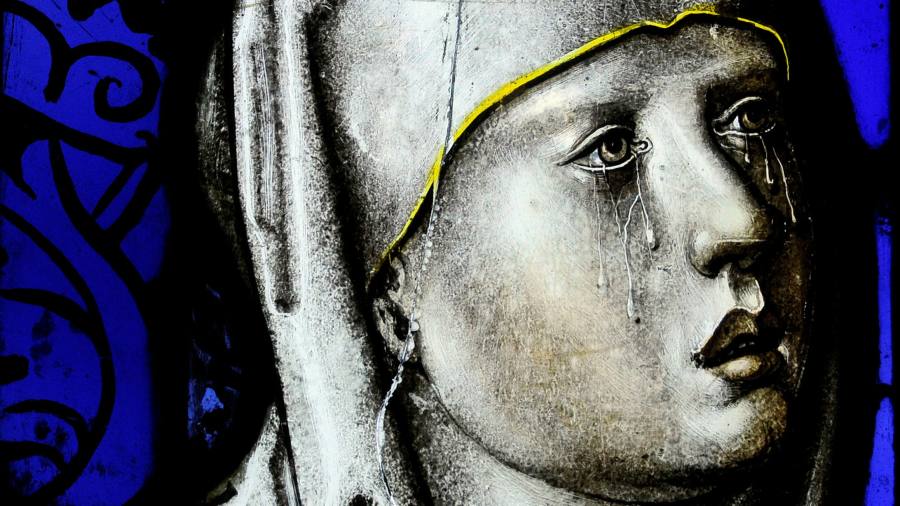The blues ain’t nothin’ but a black crepe veil, ready to wear — Duke Ellington
In 1966 the American drug company Merck launched a new marketing campaign for its antidepressant Elavil — otherwise known as amitriptyline, and still prescribed today for some kinds of physical pain, including migraine. Merck’s admen had hit upon a curious gimmick.
Symposium in Blues, released in collaboration with the record company RCA Victor, is a compilation album of old blues songs — Ellington, Louis Armstrong and Ethel Waters all feature — accompanied by calm promotional prose about this “highly effective, well tolerated” medicine. On the record’s cover, a young blonde white woman dreamily rests her head on one hand, in a melancholic pose at least as old as Albrecht Dürer’s famous engraving of a downcast angel. At a time when pharmacology promised relief from depression, there was also money to be made acknowledging that mental agony had its historical and even aesthetic aspects.
This insight might not have been news in the 17th century, when Robert Burton wrote his vagrant and capacious The Anatomy of Melancholy. As the literary scholar Mary Ann Lund tells us in A User’s Guide to Melancholy, the Anatomy is “perhaps the largest, strangest, and most unwieldy self-help book ever written”.
Burton treats of body and mind, sex and study, diet and landscape — because melancholy touches all of this and much more, threatening to devour the erudite author and his world. Later descriptions of depression, the medical and cultural descendant of melancholy, have tended to delimit the disease rather than find it everywhere. For Freud, it is a kind of misplaced mourning. For his contemporary Emil Kraepelin, an organic illness of the brain. And in the popular imagination today, the consequence of a “chemical imbalance”.
As a clinical reality depression is ever present, but it has its cultural seasons and styles, from the melancholic fashion of Burton’s time to the Prozac craze in publishing of the mid-1990s. And beyond: numerous recent articles have warned us that a dam-burst of mental ill-health awaits on the other side of the coronavirus pandemic, or has already started leaking through in the trauma of survivors, in unresolved grief for those who died alone, in gnawing anxiety among the young.
During lockdown, those of us already familiar with depression’s plague-marks have watched for the signs in ourselves and others, while the previously undepressed have begun to get an inkling of common symptoms: insomnia, agoraphobic withdrawal, rumination and “brain fog”. This fraught moment seems a good one at which to review the literature on depression today — as well as to wonder what “the literature” might mean.
In some ways, the current crop of books about depression repeats a generic tendency whose best expression may have been Andrew Solomon’s The Noonday Demon (2001). Solomon’s combination of memoir, medical history, polemic on behalf of stigmatised patients and (seemingly) disinterested assay of contemporary treatments: all of this is present in new books by Oliver Kamm, Horatio Clare, Alex Riley and (laconic, philosophical outlier) Eva Meijer.
But these books are also very different from each other, and not only because their authors’ experiences have been so various. There’s a tendency among depressive memoirists and personal essayists to argue strongly and generally for the particular origins, treatment and even solution that mark their own case. So that reading a cross section of writers, you get a keen sense of how contested, still, is the search for cause, cure and meaning.
“Midway this way of life we’re bound upon / I woke to find myself in a dark wood”, wrote Dante. Kamm was 50 years old when one day he suddenly found he could not remember where he lived. Other symptoms followed: constant tears, bone-deep lassitude, raging guilt about his qualities as a parent, the collapse of concentration and productivity. Friends fed him, and colleagues covered for him, while Kamm, a journalist with The Times, sought help for the worst pain he had felt in his life.
Mending the Mind divides more or less equally between the story of Kamm’s breakdown, his survey of current knowledge and possible cures, and a plea for the under-acknowledged reality of mental illness. I suspect many readers will find it strange that Kamm seems to have reached middle age with barely a clue, before his own crisis, about the nature and prevalence of depression.
His is an oddly schematic and detached book, in part because he sees no connection between the period of his depression and the rest of his life, which here remains determinedly unexamined. He revolts at a therapist’s suggestion they talk about his childhood, and Kamm’s contempt for her leaches sourly into the rest of his book. He insists his depression was a matter of a diseased brain and disordered thinking; the unquestioned remedy is a regime of antidepressants and a course of cognitive behavioural therapy.
Naturally, one is pleased that he has found a solution to his suffering, but Kamm’s huffish conviction that his is the only rational or evidence-based path begs all the questions a desperate, or simply curious, reader may have. Alex Riley’s A Cure for Darkness, by contrast, offers a rich and generous picture of research into depression to date, up to and including recent work on a possible relation to the body’s inflammatory response, and encouraging results of treatment with psychedelic drugs.
Riley’s own postgraduate brush with depression structures his book, but the most striking thing about A Cure for Darkness is its acknowledgment of disparate experience — for patients, as well as their physicians or therapists — and extreme complexity. Riley reminds us that there have been cultures (China under Mao, contemporary India), where depression doesn’t “exist” as such. And where it is recognised, there are patients who’ve been helped by old-fashioned talking cures, by diet or exercise as much as the new pharmacology or the decades-old rigours of electroconvulsive therapy.
Equally generous-minded is Horatio Clare’s Heavy Light, his account of an extravagant bout of bipolar bewilderment and a search for treatment outside of the frequently numbing menu of lithium and various antipsychotics. Clare’s florid madness involved illegal drugs, infidelity, deliberately crashing his car and believing himself married to Kylie Minogue. The slo-mo catastrophe ends with Clare, who is a wildly endearing narrator of his own turmoil, being hospitalised under the Mental Health Act.
At this point Heavy Light turns outwards from his own tale to include first the patients who’ve been sectioned alongside him, and then the wider community of the mentally unwell in Britain today. Clare’s is a persuasive argument not only against chemical answers to his own illness, but also against the hasty (and often permanent) way individuals are labelled with diagnostic categories. Among a group of healthcare professionals in Kent, Clare finds a new commitment to “open dialogue” between the sick and the well. Even among contemporary psychiatrists, a move towards “deprescribing” is taking hold.
A caveat about all of these books, however valuable or well intended: like most volumes of the sort, they are written from a vantage of relative privilege. From William Styron’s Darkness Visible (1989), through Elizabeth Wurtzel’s Prozac Nation (1994) and Solomon’s The Noonday Demon, a narrative arc of gilded flight and Icarus fall is very much a feature of the genre. In the new books, a certain stultifying literary and journalistic milieu dominates (less so in Riley): book festivals, famous friends, maddeningly easy access to experts in the field. And of course, a return to health and all that follows. We lack, still, a non-professional literature of lives instead saturated with depression, lives lived without an inkling of truly useful diagnosis or consoling recognition, never mind recovery. Let alone redemption in print.
The challenge, of course, for any personal writing about depression is to make the most deathly of moods come alive on the page, and to some purpose. Whatever else they may be, the lives of the bipolar, such as Clare, are at least filled with colourful incident. The same cannot be said of the merely melancholic, whose retreat into silence, inaction and sorrow calls to mind those stilled, retrospecting souls out of late Beckett, rocking their way towards oblivion. But most writers are not Beckett — or pick your favoured laureate of the void — so there remains a problem for the writer about depression: we all start to sound the same. We’ve all got a fog in the brain, all our days have declined to a uniform grey, we all tend to repeat versions of Sylvia Plath’s bell jar — an image even she does not belabour. The metaphors solidify even as we are falling apart.
The Dutch writer Eva Meijer is well aware of this danger. The Limits of My Language is a short book, and blessedly reflective rather than compendious: it is something of a relief not to have the whole history of the disease, from Hippocrates to Prozac, rehearsed again. “I’ve always had an aversion to comparing depression to monsters, demons or animals (and certainly to dogs, because how can they be blamed?), and I dislike metaphors that use the colour black, ” she writes. “Metaphors aren’t useless, of course. Imagine carrying a sea inside your body.”
Though Meijer touches on drugs and therapy and their contemporary cultural context, she is just as interested in what depression tells us (weak phrase for what feels so intimate and ingrained) about being human, about the inevitability of pain and death. More than Freud, Kraepelin or Aaron Beck (pioneer of CBT), her guides are Wittgenstein, Merleau-Ponty and the pragmatist philosophers. The Limits of My Language is a more accessible, even chatty, book than this might make it sound.
Reviewing Andrew Solomon in 2001, the critic Ian Penman wrote: “Because its estate is one of mute disenchantment, you lack even the mortal consolation of art. Art is a field alive with sun motes and glyphic rooks; depression is the severed ear.” This makes sense, and makes sense too of the severe difficulty of subliming the treacly substance of one’s own melancholy into art, or even just vivid prose free of cliché. But the ambition remains to make, or to find, a formal language, a set of images or sounds, that will do justice to unspeakable psychic pain.
Most of the writers under review gesture towards art’s capacity to express or assuage. Kamm turns to Keats, Samuel Johnson and Emily Dickinson. Meijer, alongside the philosophers, invokes the spectral self-portraits of photographer Francesca Woodman (dead by suicide at 22) and the abject spectacle of Tracey Emin’s unmade bed. “Our language is insufficient,” one of the Kent team tells Clare. Surely any future vision of treating the whole depressed person must address problems of expression, imagination, wisdom. I cannot always see the light — please tell me if it shines.
Mending the Mind: The Art and Science of Overcoming Clinical Depression, by Oliver Kamm, Weidenfeld & Nicolson, RRP£16.99, 320 pages
Heavy Light: A Journey Through Madness, Mania & Healing, by Horatio Clare, Chatto & Windus, RRP£16.99, 352 pages
A Cure for Darkness: The Story of Depression and How We Treat It, by Alex Riley, Ebury, RRP£18.99, 464 pages
A User’s Guide to Melancholy, by Mary Ann Lund, Cambridge University Press, RRP£19.99, 268 pages
The Limits of My Language: Meditations on Depression, by Eva Meijer, Pushkin, RRP£9.99, 144 pages
Brian Dillon is the author of ‘Suppose a Sentence’, ‘Essayism’ and ‘In the Dark Room’
Join our online book group on Facebook at FT Books Café






